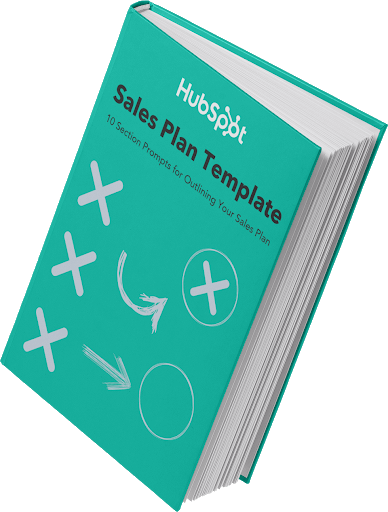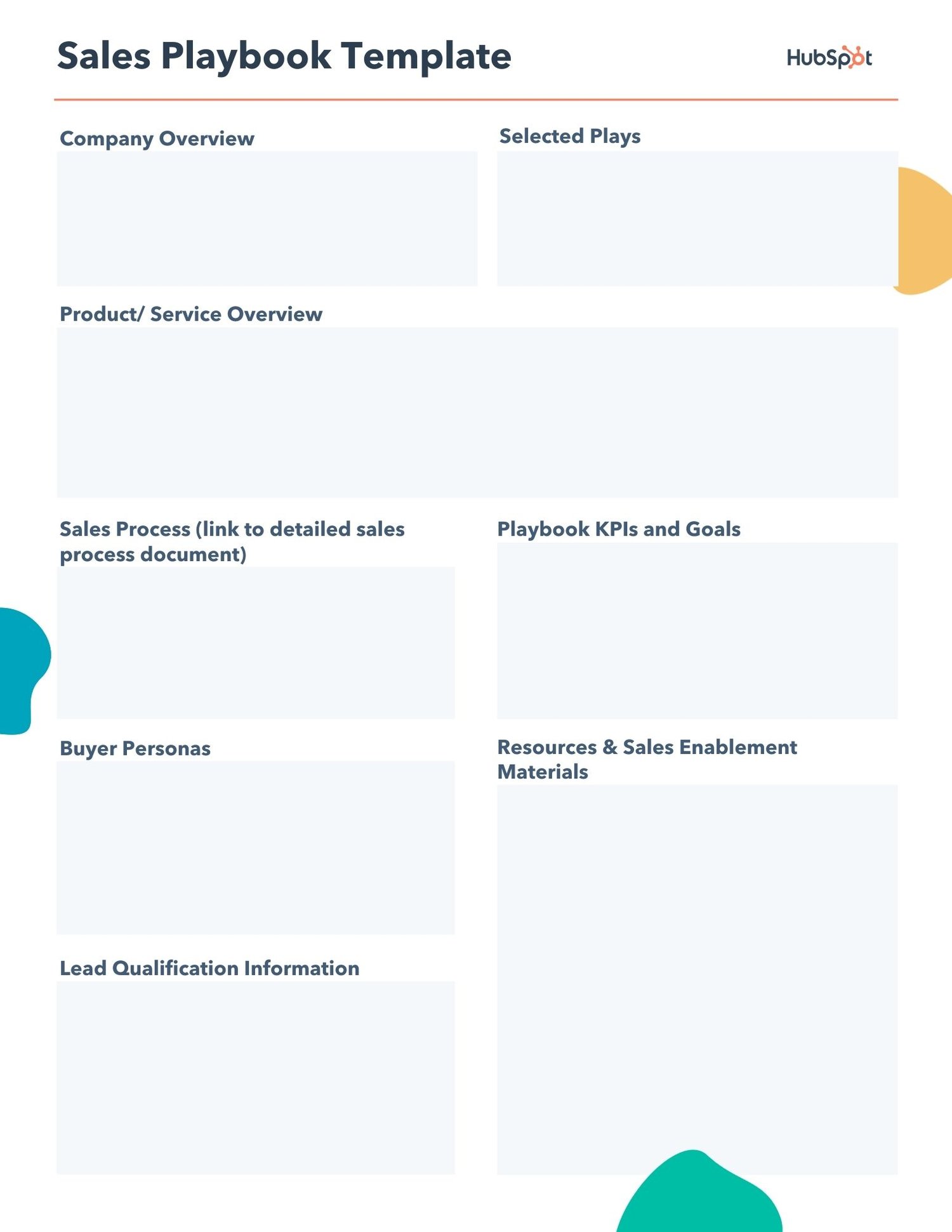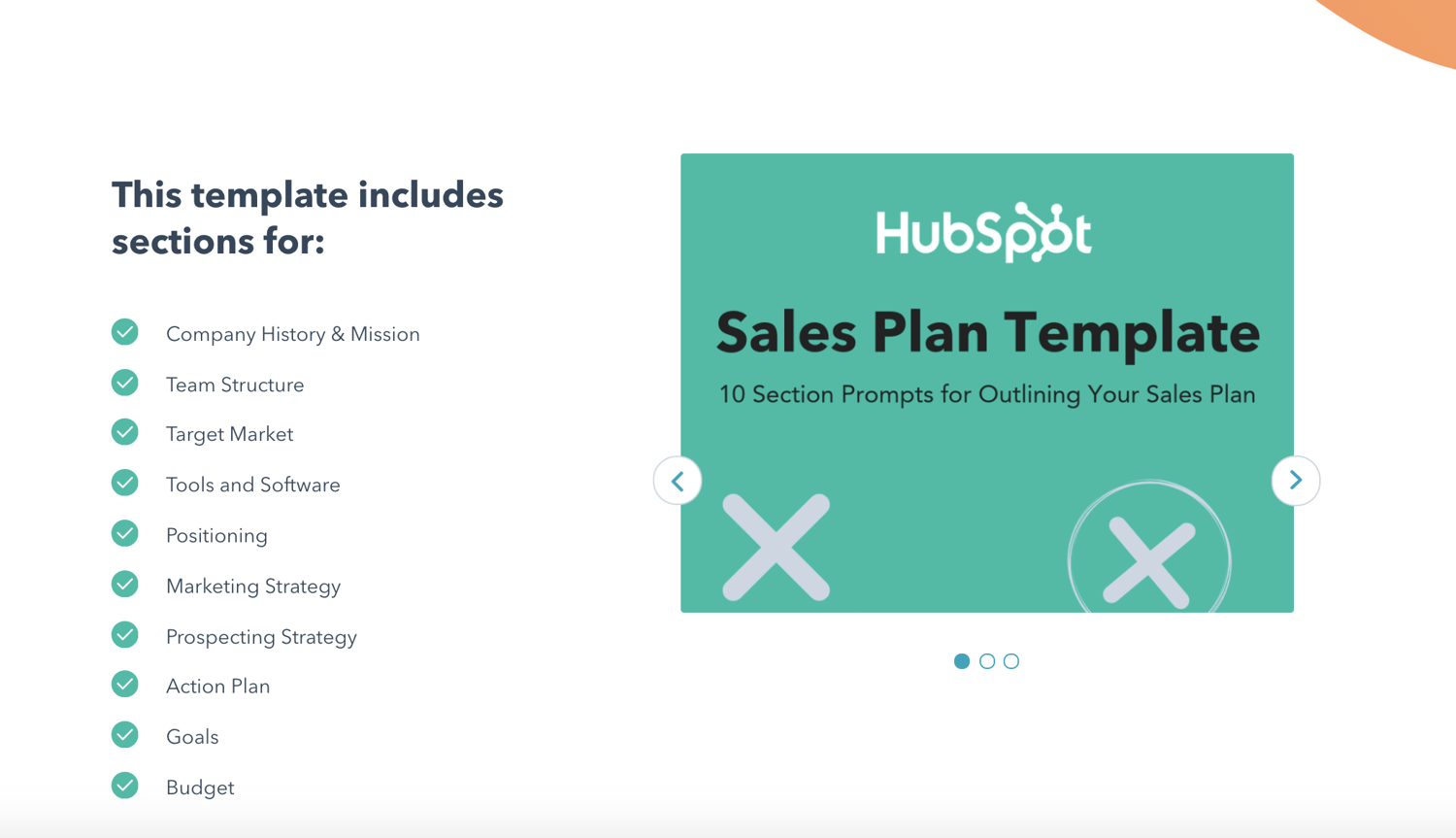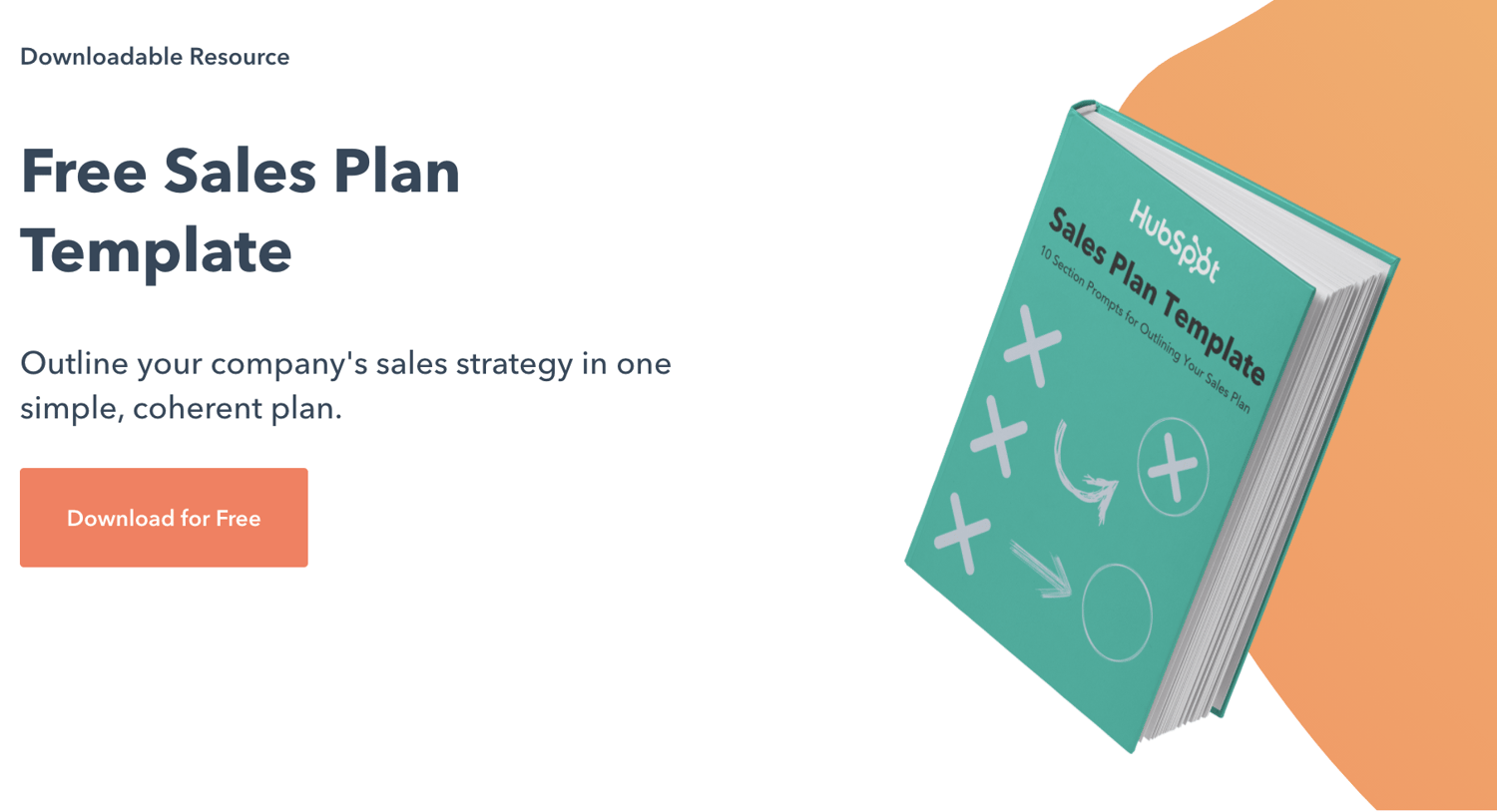Want to improve productivity across your sales team, standardize best practices, reduce ramp-up time, and make your salespeople more autonomous?
Create a sales playbook.
Without a playbook, your sales reps have to come up with a different angle every time they talk to a prospect or lead. What if you could consolidate every pitch, tactic, email, and call script that’s been successful? What if you could distribute it to everyone on your team in one easy-to-read document?
That’s what a sales playbook is. It’ll help you and your team sell more efficiently, exponentially improving the bottom line at your company.
In this guide, we’ll talk about what a sales playbook is, how to create one, and plays to consider running, as well as introduce you to a template to help you throughout the process. Let’s get started — and don’t forget to follow along with HubSpot’s free Sales Plan Template.
A sales play includes things like sales enablement materials, strategies, discovery call questions, KPIs, buyer personas, sales process details, and more.
Sales reps also benefit from other helpful information in sales playbooks like sample emails and scripts to guide reps through all parts of the buyer’s journey and actions.
Use a Sales Playbooks Tool that connects to your CRM and arms your sales team with competitive battle cards, call scripts, positioning guides, and more.
Benefits of a Sales Playbook
Although crafting a sales playbook can be a time-consuming process, it’s worth it — you’ll start seeing results almost instantly.
With a sales playbook, you can…
1. Make new hire training quicker and easier.
First, training new salespeople is far quicker and easier when you have clear, explicit explanations of who your customers are, how they buy your products, what pain points they experience, what to say to them, and more. Without a sales playbook, your reps are forced to learn this information ad hoc.
2. Free up valuable time for reps.
Second, a playbook frees up time for selling. When sales reps spend too much time searching for or creating content, they can’t focus on nurturing deals and closing sales.
Rather than having each rep develop their own messaging, questions, and resources to use with prospects, give them ready-made content — a.k.a, focus on sales enablement. This will give your reps more time for selling.
3. Surface the most effective selling techniques.
Third, a playbook helps you disseminate the most effective techniques being used on your team. For instance, if you notice one rep having success with a specific outreach method, you can share it easily with the entire team by putting it in the playbook.
Speaking of surfacing your best techniques, a sales playbook also highlights and shares your most effective sales plays for specific scenarios.
If a sales playbook is a manual, a sales play is a specific tutorial within the manual.
You can create a sales play for one specific stage of the sales pipeline. You can also create sales plays for different types of customers. These are only two of the many different types that you can include in your playbook.
Sales Plays to Include in Your Playbook
Sales plays are unique to your specific company and goals, but here are some examples of plays that you may choose to create playbooks for:
- Personalized content play: Focus this playbook on how reps can personalize and tailor the buyer’s journey to specific leads and prospects through their interactions and the content they share.
- Lead qualification play: Focus this playbook on how reps can efficiently identify highly-qualified leads to reach out to.
- Demo play: Focus this playbook on how reps can effectively demo specific products, and even features, to their prospects.
- Use case play: Focus this playbook on a specific use case that many members of your target audience experience.
- Prospecting play: Focus this play on how reps can prospect on a certain platform or channel, or specific tactics they can follow to identify ideal prospects.
- Closing play: Focus this play on how reps can move a lead who’s late in the buyer’s journey into the closing phase in a way that feels natural, professional, and effective.
- Follow-up play: Focus this playbook on how and when reps can follow up with leads at different points in the buyer’s journey.
Next, let’s talk about how you can write your own sales playbook.
How to Write a Sales Playbook
Your sales playbook is unique to your business — however, the following steps for creating your playbook apply to nearly any business’s sales team.
Follow Along With HubSpot’s Free Sales Playbook Template

Download Your Copy for Free
1. Review (and, if necessary, update) your sales process.
Since your sales playbook is a part of your sales process, you want it to fit in seamlessly. And your sales process should be analyzed frequently to ensure it’s updated in a way that complements your current goals, the way your reps sell, your latest products and features, your buyer personas, and more. This is why the first step of sales playbook creation is to review your current sales process.
2. Outline your sales playbook goals.
Next, outline your sales playbook goals. These goals may revolve around questions like the following:
- What does the playbook need to include?
- Which specific aspects of the buyer’s journey and sales process need to be touched on?
- What are reps struggling with that can be explained in the playbook? (For example, if your reps are struggling with qualification, your sales playbook may include qualification sample questions, qualification frameworks, and common-fit indicators.)
- What do you hope to get out of the playbook?
- When should the playbook be finalized?
Make your playbook goals specific — reps will be more likely to adopt a short, focused, and relevant playbook over a long, complex, multi-faceted one.
For example, if your biggest priority is improving product demo quality, your playbook should cover presentation strategies, various value propositions, and sample messaging that’s linked to your product’s features.
3. Determine who should be involved in the sales playbook creation process.
Determine who should be involved in the sales playbook creation process so you can invite them to join collaborations.
The people and teams you’ll likely want to be involved in the process include:
- Sales reps
- Sales VPs, directors, and managers
- Marketing team members (specifically, marketers who work on content, product, and sales enablement materials)
- Subject matter experts
This is also a good point in time to identify directly responsible individuals (DRIs) for the creation of the sales playbook so that other team members know who’s leading the effort and who they can reach out to with questions and comments.
4. Align your sales team with your marketing team.
And speaking of looping in certain individuals and teams, sales alignment with the marketing team is critical to the sales playbook creation process.
Your sales playbook, no matter its focus, is bound to need content, sales enablement materials, and educational information that reps can refer to and even share with prospects.
Also, by keeping the communication and collaboration lines between Sales and Marketing open, Sales can inform Marketing of what types of content and materials they need to streamline and enhance the selling process. And Marketing can reach out to Sales with information about their latest campaigns and content about new products or feature updates.
5. Collect your buyer persona information.
Reps must have a deep understanding of the business’s buyer personas. That’s because the purpose of your sales playbook is to help reps meet leads where they are. It’s meant to help reps reach leads by supporting them through a specific part of the sales process.
Collect that information and share it with your reps so they’re able to refer to it when applying and prepping the sales playbook (and while working through the rest of the sales process).
Note:As your business grows, the product line expands, and your base of customers includes more people, continually update your buyer personas as needed.
6. Provide product and feature training and education for reps.
This is a critical step for all aspects of selling, not just the creation of your sales playbook — reps must understand the product they’re selling inside and out.
No matter how good your sales playbook is or what the playbook is about, your reps won’t be able to apply it effectively unless they have a deep understanding of your product, its capabilities, and its features.
Think about ways to encourage and host this training as well as when your reps will undergo training. For example, you may have reps attend training sessions with your company’s product team. Or maybe your reps are required by sales managers to test out the product as a customer would.
7. Audit and update your sales enablement materials and content.
Next, audit your existing sales enablement materials. In doing so, you’ll be able to determine what already exists and can be used as-is, or needs to be edited. You’ll also be able to make note of which sales enablement materials need to be created (hence why we mentioned the importance of sales and marketing alignment).
8. Choose your plays.
There are a number of plays you can choose from when determining what the focus of your playbook will be. This is entirely dependent on factors like:
- Which parts of the sales process in which your reps need support
- What the product or service is for
- Who your buyer personas are
- What your overall sales goals are
9. Implement and share your sales playbook.
Now it’s time to implement and share your finalized sales playbook. Reps should all have access to the playbook, as should sales managers, directors, and VPs. It may be helpful to share the finalized sales playbook with Marketing as well to continue collaboration and transparency between the two teams.
10. Analyze the success of your playbook.
Similar to everything else in business, you must analyze the success of your work. Once your sales playbook has been shared and used by reps, keep tabs on its relevance, success, and helpfulness.
Ask reps for their opinions on the playbook and its usefulness. For instance, you might conduct a survey to get feedback on the playbook. This way you can effectively update and edit the playbook as needed to ensure greater or continued success.
Next, let’s talk about a resource that can help you with the entire sales playbook creation process — a playbook template.
Sales Playbook Template

A sales playbook template is a great way to ensure you create a playbook that’s as effective as possible for your team. In this free, customizable template, you’ll be able to work through your sales plan and playbook at the same time to ensure they’re complementary.

Every business’s sales playbook will be unique. However, you can refer to this template no matter what type of business you work for or what your sales playbook goals are.

Outline your company’s sales strategy and playbook(s) with this free, customizable sales plan template.
What to Include in a Sales Playbook
Let’s review the elements of this template.
1. Company Overview
Provide a company overview and dive into details about the sales organization. Include information about how the sales org is constructed, who manages each team, which targets reps and teams are expected to hit, and so on.
2. Selected Plays
Identify which plays will be used for each playbook you create to clearly define the playbook’s purpose for reps.
3. Product/Service Overview
Cover every product or service reps are responsible for selling. Mention price points, use cases, core value offerings, buyers, end-users, and related industries or verticals.
You may choose to create one sales playbook for each product you sell if they’re all fairly different, require radically separate buying processes, have different buyer personas, or are sold by different members of your sales team.
4. Sales Process
Explain each step of your sales process from first touch to close. You might just link to your sales process document here so reps and sales managers can easily refer to it.
5. Playbook KPIs and Goals
Which metrics do your company’s sales managers track most closely? Which should the salesperson be paying attention to? Are there any baseline numbers they should know about?
To give you an idea, maybe you’ve found reps who make 50-plus calls per day are significantly more likely to hit quota.
6. Buyer Personas
Include your buyer personas so reps can quickly hone in on the most qualified leads, and target their unique needs and challenges.
7. Lead Qualification Criteria
Include lead qualification criteria so reps can refer to them in tandem with buyer persona information. For instance, maybe a qualified lead at your company means the lead is ready to buy in the next three months, or already has sufficient budget to make a purchase.
Include expectations around prospecting and follow ups here too. Provide some guidelines around when to pursue opportunities and when to let them go.
8. Resources and Sales Enablement Materials
To create an effective sales playbook, you need to have ample resources and sales enablement materials for your reps. This requires a strong relationship between the sales and marketing teams, which you can define in this section. It also means education for reps about available resources and materials is necessary (e.g. case studies, product pages, social content, demo videos, CRM, sales software, sales technology, etc.). List those resources in this section too.
If you’re feeling stuck, take a look at the following sales playbook examples from real brands.
Sales Playbook Examples
While sales playbooks are typically internal documents, some companies publish their playbooks. Check out a few of our favorites below.
1. HubSpot and Join.me Sales Meeting Playbook
This two-page playbook was created in a joint effort between HubSpot and Join.me. It outlines what a rep should do before and during a sales meeting to increase the chances of closing the sale.
The playbook is divided into seven sections, but don’t let that number fool you. With its clear headings and easy-to-scan checkboxes, the seven sections fly by quite quickly. In order, they are:
- Research Prior to Meeting: Offers guidance on exactly what sales reps should research before the meeting.
- Set the Agenda: Includes an example of how sales reps can set the agenda for the meeting.
- Discovery Phase: Lists out a few questions reps can ask to uncover information about the prospect’s business, as well as their needs.
- Assess the Need: Includes additional questions to diagnose the problem and understand what can be improved.
- Define their Buying Process: Includes more questions sales reps can ask to understand the client’s purchasing process.
- Demo: Offers a few tips to carry out a demo that closes the deal.
- Close: Shares an example of what sales reps can say to finish the conversation and win the deal.
Why this Sales Playbook Works
The power of this playbook lies in its length. It shows that you don’t need to write a 27-page-long manifesto. With just a few quick bullet points, you can guide your sales reps to success. Most importantly, it provides examples of what sales reps can say.
2. Global Telecom Solutions Partner Playbook
Global Telecom Solutions uses this well-structured sales playbook to provide discovery questions and tips to their solution partners.
This playbook isn’t too prescriptive, which is why it’s so effective. Every spread is dedicated to one type of customer, and each has four noteworthy sections:
- Discovery Questions: Includes the questions each sales rep should ask prospects in that specific industry.
- What to Listen For: Lists a few keywords and terms sales reps should listen for in the prospects’ answers.
- Contacts: Outlines who sales reps should reach out to at the target businesses.
- Did You Know? Includes pieces of information that emphasize the importance of GTS’s solutions.
Why this Sales Playbook Works
The structure is easy to follow because every spread is dedicated to a different type of customer. It also provides useful guideposts, but isn’t overly prescriptive, allowing sales reps to shift gears if need be.
3. Cobalt Iron Partner Playbook
Cobalt Iron’s playbook for its partners is a classic example of a well-executed playbook. It provides an overview of the company and the product, then shares several elevator pitches that partners could use.
It also provides information on the state of the industry, so that partners can understand where the product falls in the current landscape.
Notable sections include:
- Elevator Pitch for Customers: Outlines common issues that customers face and reasons why customers should adopt the solution.
- Customer Challenges: Gives further insight into the customers’ needs, then goes into specific challenges as they relate to the product.
- Target Customer Profile: Outlines the characteristics of a customer who needs the product.
- Buyer Profile: Offers more detail into specific buyer personas at prospect businesses.
- Managing Objections: Shares common objections and ways to respond to them.
- The Competition: Includes easy-to-scan bullet points on how to compare the product to competitors’ offerings.
- Conversation Starters: Offers a few questions solutions partners can use to get the conversation rolling.
Why this Sales Playbook Works
It’s thorough, comprehensive, and well-thought-out, and includes extensive information on the state of the industry and the challenges that prospective customers face. While it’s long, a great sales rep won’t shy away from reading — not if it’ll help them meet quota.
Create and Use a Sales Playbook
A sales playbook will increase efficiency in your team and improve close rates across the board. But don’t let the document stagnate. Update your sales playbook as your sales process changes and improves, your product line expands or shrinks, your ideal customer shifts, your strategy evolves, or your sales compensation plan is tweaked. Refer to and use the steps we covered, and the template we provided, to help you along the way.
Editor’s note: This post was originally published in November 2017 and has been updated for comprehensiveness.

![]()




